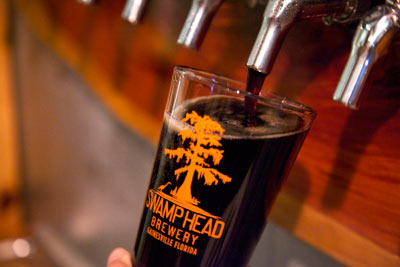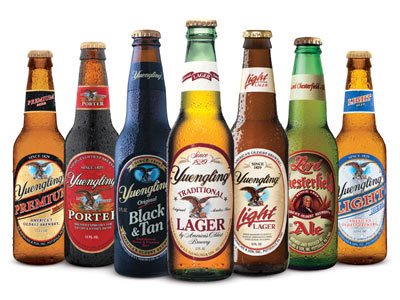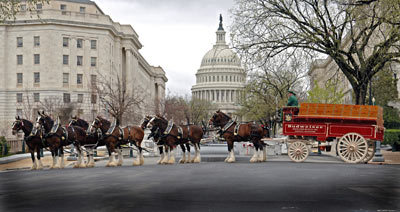
You arrive at your neighbor’s summer party, greeted by a throng of old friends and new faces. You chat with the party’s host, the sun blazing on your shoulders. Beads of sweat begin to form on your forehead when it finally dawns on you: You’re extremely parched.
You head to the cooler and reach inside, your fingers recognizing the familiar sleek long neck as your hand grasps the copper bottle. You pop off the cap with the bottle opener on your key chain and a wispy white fog floats from the rim, like a genie from a bottle. The cold liquid splashes your taste buds. An appeased smile curves your lips.
There’s something magical about beer. Like a sorcerer’s potion, the bottled brew seems shrouded in mystery, a mystery I intend to unravel. After patiently—OK, semi-patiently—typing in my age every time I visited a company’s website, emailing team members about tours and tasting rooms and traveling to where beer is brewed and bottled, I find not only a new appreciation for the beverage but a respect for its long journey to a summer party’s patio cooler.
The Growler Life
Since the early 2000s, microbreweries have been cropping up due to the public’s growing interest in home brewing and craft beers. Swamp Head Brewery, which prides itself as “inherently Floridian,” is one such microbrewery in Gainesville, treating beer enthusiasts to its year-round fleet.
At the dead end of SW 42nd Way, far back behind the Glass Doctor’s parking lot, I find a giant warehouse with a large, closed-off room and copper kettles more than twice my height. It smells like I’ve stepped into a breakfast cereal manufacturing plant. I clear my throat and call out a greeting to see if anyone is within the cornflake-smelling vicinity. Circling the shiny kettles, I turn a corner by the glass room and see a man monitoring the machines. He points me to Swamp Head owner Brian Kemper’s office. I wait outside Brian’s door while he’s in conference with head brewer Craig Birkmaier.
The brewery gives off a laidback vibe. The Swamp Head team’s uniform of choice is polo shirts, flip flops (except around the kettles where members where boots) and baseball caps. After Craig exits, I enter Brian’s office with its fishing photos and swamp images decorating the walls. I sit down, and Brian tells me Swamp Head’s story.

A Gainesville Secret
A microbrewery is like a local coffee shop or diner; those in the know will be hard pressed to tell you their city’s hidden treasure. Besides Swamp Head’s literal off-the–beaten-path location, Luke explains being a microbrewery in the corner of the country has its drawbacks, and Florida is just recently joining this new wave of home brewing.
A Gainesville native, Luke studied business administration at the University of Colorado, where he developed a love for craft beer. After graduation, he planned to attend graduate school when his stepdad Craig piqued his interest once again in craft beer. Craig started home brewing in his garage in 2002. While Craig crafted beer, Brian crafted a business plan and founded Swamp Head Brewery in 2008. The following year, Swamp Head released its first batch of kegs.
“We’re pretty small for a production brewery,” Luke admits. “But our goal is to make excellent beer, not shorten the process.”
The brewery runs on a 10-barrel system, which equals 310 gallons of beer. Because of small-scale production, Swamp Head only ships its beers to restaurants and pubs to sell on tap. Only a few places in Florida offer Swamp Head drafts. The brewery opens its tasting room three times per week and sells 32- or 64-ounce “growlers” of beer.
Luke shows me the tasting room, aka The Wetlands. It’s a dark room decorated with craft beer bottles from around the world.
Back in the area I walked through earlier, I meet brewer Nick Dunn, who is the kegging technician.
“All I do really is press buttons,” says Nick. “People think working at a brewery is glamorous. It’s not glamorous.”
“Everyone thinks we sit here all day and get drunk,” adds Luke, “but there’s no drinking on the job.”
But you can drink while Luke and his team are at work. Go to swamphead.com for tasting room hours and information on where to get Swamp Head’s brews on tap.

The Oldest American Brewery
Ten times larger than Swamp Head, the Yuengling Brewery in Tampa is one of three Yuengling breweries in the U.S. Family owned and operated, Yuengling is the oldest American brewery.
For over 180 years, D.G. Yuengling & Son has bottled its brews to quell the thirst of the American public. The drink is named after its founder David “D.G.” Yuengling, whose last name (pronounced “ying-ling”) means “young man” in German.
Surviving the prohibition era and continuing expansion in the present day, the company had a modest beginning in 1829. D.G., a 23-year-old immigrant from Württemberg, Germany, opened Eagle Brewery in Pottsville, Pennsylvania. Today, the fifth generation has taken up the family mantle, with Dick Yuengling, Jr. at the helm. Once Mr. Yuengling is ready to step down, the company will not only be America’s oldest brewery but also America’s only all-women-owned brewery. Mr. Yuengling’s four daughters are next in line to take on the family business. At present, however, Mr. Yuengling calls the shots.
I manage to make the 10am tour and join a group of 15 at the Yuengling brewery. Our guide Janis begins our tour telling us about Yuengling’s history. While the Mill Creek brewery in Pennsylvania was still under construction, Yuengling opened the Tampa brewery in 1999. Originally owned by Stroh Brewery Company, the brewery came readily equipped with brewing facilities and job seeking workers. Yuengling distributes its beer in 15 states, including New York, the Carolinas and Florida. The brewery is currently undergoing expansion with the goal to take on new territory.
“We don’t know which states yet,” Janis says, “Only Mr. Yuengling knows.”
After the introduction, we are led to a door with a yellow sign reading, “Danger: Restricted Area.” Intrigued, I’m one of the first through the door, the rest of the group moving sluggishly. I’m guessing they’re from out of state and still adapting to the early spring Florida heat.
Instead of a cereal scent like Swamp Head, the stairway leading to the kettles smells metallic, like a handful of coins. As we travel upward, the yeasty aroma of beer becomes stronger. We enter the brew kettle room, where the liquid inside the kettle is a murky brown, which Janis accurately describes as resembling the Mississippi River. The brew kettle fills up seven times a day and runs for 24 hours.
We make our way to the lab, where Janis says we’re to meet Randy the chemist, who has the coveted job of beer taster.
“This isn’t wine tasting!”
Iseem to enter what looks like a high school science classroom with low tables, several sinks, cabinets and jars. Beer taster Randy, whose official title is chemist, is busy downstairs—probably hard at work.
“Will his job open up some time?” jokes a man in a striped blue shirt.
Crowded around a table with glass containers, Janis hands them out to pass around. There are three jars of different colored malt—caramel, pale and black—and a small flask of pellets.
“What is this,” a woman asks, “rabbit food?”
Janis explains the jar is full of hops in their pelletized form, when Randy walks in.
We are under the impression that Randy’s taste buds are sharper, almost super human. However, according to the taste master himself, everyone has the ability to acknowledge beer’s many attributes.
A taste master for 40 years, Randy also relies on a panel of tasters. Besides graphing the beers’ quality, he also monitors the panel to make sure their reports are consistent.
“You spit while tasting, right?” someone asks.
“I don’t spit!” Randy says. “This isn’t wine tasting!”
Laughing, we let Randy get back to his job and enter the last leg of our tour where we view packaging.
While we gaze at bottles rotating on a silver carousel below, Janis builds up anticipation when she tells us which beers will be on tap at the bar when we get back to the welcome center. Suddenly, the sluggish group from earlier is replaced by an eager crew with a bounce in their step.
At the bar, I’m undecided about which beer to choose when Janis says, “We still have green pale ale on tap, so if you didn’t have green beer in March, now’s your last chance!”
I immediately approach the counter, and a bright green cup of ale with a thin head of foam is placed in my opened palm. The beer tastes rich and slightly acidic. I lick the foam from my upper lip and wonder if my tongue’s turning green. After finishing my drink, I ask for a cup of Yuengling’s Premium beer and delight in the light, fruity taste of the pale malt.
The next tour group trails in as we taste our beer and make more requests. The new crew looks on enviously, as they won’t have their fill until the end of their tour. Finishing the last gold drop of Premium, I debate on whether to tell newcomers it’s well worth the wait. Then, I see the gift shop around the corner. I wonder if those pint glasses come already filled…
You can be the envy of your friends—or take them along for the ride—by going on a Tampa tour of your own. Visit yuengling.com for tour schedules.

Three Words: Bud. Weis. Er.
Budweiser, debatably the most iconic beer brand in America, is last on my list of breweries to visit. When Budweiser’s Jacksonville brewery opened in 1969, it produced 1.7 million barrels of beer. This past year, Jacksonville produced 9.7 million barrels. Let it be known that Jacksonville is only one of 12 breweries and that each barrel of beer holds 31 gallons. Did you imagine swimming in the Budweiser Sea? I know I did. However, Budweiser isn’t the only beer brewed in Jacksonville. Anheuser-Busch Companies, Inc., owner of Budweiser, also distributes Stella Artois, Shock Top, Bacardi Silver, Bud Light and many others. These brands are household names, but Budweiser may rate the highest when it comes to nostalgia.
At the 205-acre brewery, I’m greeted with a thoughtful surprise after a long trip: a Bud Light Platinum sample. My group of 20 scans the display of Anheuser-Busch products—Wild Blue Blueberry Lager, Michelob, Land Shark—while our tour guide Charlie introduces himself. We dispose of our cups after being assured there’s more where that came from and head to the elevator where we’ll get off at the brew hall.
As we step into a warm, humid hall overlooking brew paddles, lager tanks and water tons, I am enveloped in the sweet grainy aroma of malted barley, which smells like beer bread baking in the oven. Charlie explains the plant makes 33 brews a day. The brewery has 400 full-time and 200 part-time employees who work in 8-hour shifts. The tanks, which are refilled as soon as they’re empty, run 24/7. No breaks for them.

Pour Me Another One, Please
Through viewing windows, we see the lager cellar and its hundreds of stainless steel tanks. Beech wood chips are raked inside the tanks to increase surface area during secondary fermentation, which helps the yeast consume more sugar. Because the entire brewing process for a Budweiser beer takes 30 days, the beer in the cellar’s tanks are at various stages. The Jacksonville brewery produces 14 of Anheuser-Busch’s brands, so not all 372 tanks are full of Bud.
After viewing packaging operations, Charlie takes us to the Hospitality Room, a room that must be referred to as a proper noun. We beeline past the soda machines and are treated to pretzels and two samples of our drinks of choice. I watch a commercial on one of the Hospitality Room’s TVs as I drink a glass of Budweiser. Out of the corner of my eye, I see a few people who were on the tour smile into their glasses. The TV screen shows a symbolic scene that’s less than 30 seconds: eight majestic Clydesdales (and at one time a donkey) pulling a beer wagon, their Dalmatian mascot surveying their proud trot. In spite of myself, I smile as well, taking a last swig of my beer. A light clink on the bar’s counter announces my satisfaction. I’m ready for my second glass.
Besides regular brewery tours, Budweiser Jacksonville Brewery also offers its Beermaster tour and Beer School, which offers visitorsan enhanced brewery experience. Visit budweisertours.com for more information.






